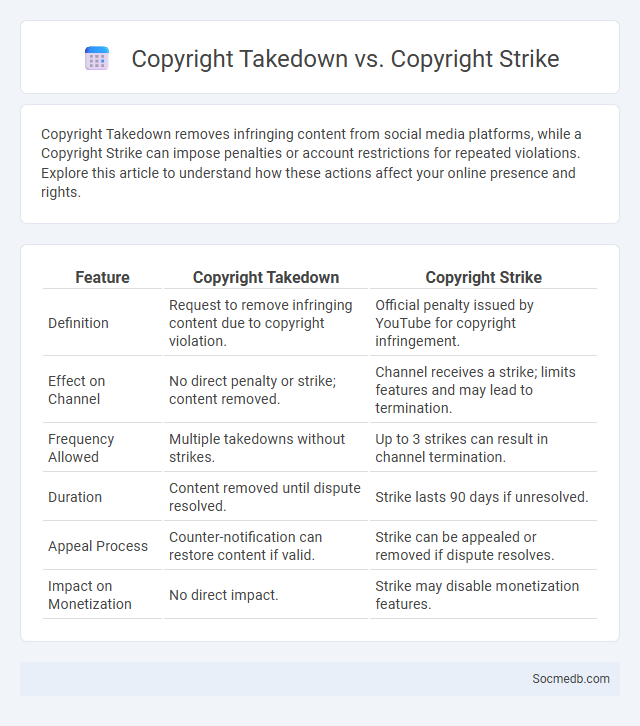
Photo illustration: Copyright Takedown vs Copyright Strike
Copyright Takedown removes infringing content from social media platforms, while a Copyright Strike can impose penalties or account restrictions for repeated violations. Explore this article to understand how these actions affect your online presence and rights.
Table of Comparison
| Feature | Copyright Takedown | Copyright Strike |
|---|---|---|
| Definition | Request to remove infringing content due to copyright violation. | Official penalty issued by YouTube for copyright infringement. |
| Effect on Channel | No direct penalty or strike; content removed. | Channel receives a strike; limits features and may lead to termination. |
| Frequency Allowed | Multiple takedowns without strikes. | Up to 3 strikes can result in channel termination. |
| Duration | Content removed until dispute resolved. | Strike lasts 90 days if unresolved. |
| Appeal Process | Counter-notification can restore content if valid. | Strike can be appealed or removed if dispute resolves. |
| Impact on Monetization | No direct impact. | Strike may disable monetization features. |
Understanding Copyright: Takedown vs. Strike
Understanding copyright on social media is crucial for protecting your content and avoiding penalties. A takedown notice requires immediate removal of infringing content without penalty, while a strike represents a formal warning that can lead to account suspension after repeated violations. You must distinguish between these to manage your social media presence effectively and comply with platform policies.
What Is a Copyright Takedown?
A copyright takedown is a legal process that enables content owners to request the removal of copyrighted material posted without permission on social media platforms. Platforms like Facebook, Instagram, and YouTube comply with the Digital Millennium Copyright Act (DMCA) by responding to these takedown notices to avoid liability for infringing content. This process helps protect original works such as videos, images, music, and written content from unauthorized use and distribution online.
How Copyright Strikes Work
Copyright strikes occur when a social media platform detects unauthorized use of copyrighted content, such as videos, music, or images, uploaded by users. Platforms like YouTube use automated content ID systems and manual reports to identify infringements, issuing strikes that can lead to penalties including video removal, account suspension, or termination after multiple violations. Understanding the specific copyright policies of each platform, as well as the appeal and dispute processes, is crucial for creators to protect their content and avoid strikes.
Key Differences: Takedown vs. Strike
A takedown is a content removal action initiated by copyright holders or platform policies, often leading to immediate deletion of posts or accounts, while a strike serves as a formal warning linked to violations like copyright infringement or community guideline breaches. Strikes accumulate and may result in temporary suspensions or permanent bans when thresholds are exceeded, whereas takedowns typically reflect a single enforcement event. Understanding the distinction is vital for content creators to manage their digital presence and avoid escalating penalties on platforms like YouTube, Instagram, and Facebook.
Legal Basis for Copyright Actions
Social media platforms must rely on specific legal bases, such as the Digital Millennium Copyright Act (DMCA) in the United States, to address copyright infringements effectively. Your ability to request content removal or takedown depends on proving ownership or authorized use of the copyrighted material. Enforcement mechanisms include notices, counter-notices, and potential litigation to protect intellectual property rights on social media.
Consequences of a Copyright Takedown
A copyright takedown on social media can lead to the removal of your content, reducing your online visibility and engagement. Repeated takedown notices may result in account suspension or permanent bans, significantly impacting your brand reputation. Protect your digital assets by understanding copyright laws and ensuring all posted materials are properly licensed or original.
Impact of a Copyright Strike on Creators
A copyright strike can severely impact creators by restricting access to key platform features, which limits content visibility and audience engagement. Your monetization opportunities might be suspended, directly affecting your revenue stream and overall growth potential. Repeated strikes could lead to account termination, jeopardizing your digital presence and long-term creative endeavors.
Responding to Takedowns and Strikes
Responding to takedowns and strikes on social media requires timely action to protect account integrity and content visibility. Users should thoroughly review platform-specific policies such as YouTube's Community Guidelines or Facebook's Intellectual Property rules before submitting counter-notifications or appeals. Maintaining clear records of content rights and communication with platform support teams enhances the likelihood of successful dispute resolution.
Preventing Copyright Issues: Best Practices
To prevent copyright issues on social media, always use original content or properly licensed materials such as images, music, and videos. You should credit creators when sharing third-party content and familiarize yourself with platform-specific copyright policies to avoid takedown notices or legal penalties. Utilizing tools like content ID systems and obtaining explicit permissions ensures your social media presence remains compliant and professional.
FAQs: Copyright Takedown and Strike Explained
Copyright takedown and strike procedures are critical for protecting your content on social media platforms like YouTube, Instagram, and Facebook. When a copyright owner submits a takedown notice, the platform removes the infringing content to comply with the Digital Millennium Copyright Act (DMCA), while repeated violations can lead to strikes against your account, potentially resulting in suspension or termination. Understanding these processes helps you safeguard your content and respond effectively if your posts are wrongly targeted.
 socmedb.com
socmedb.com